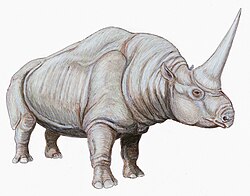| Pliorhinus Temporal range: | |
|---|---|
 | |
| Skull of Pliorhinus megarhinus at the Gallery of Paleontology and Comparative Anatomy, Paris. | |
| Scientific classification | |
| Kingdom: | Animalia |
| Phylum: | Chordata |
| Class: | Mammalia |
| Order: | Perissodactyla |
| Family: | Rhinocerotidae |
| Subfamily: | Rhinocerotinae |
| Tribe: | Rhinocerotini |
| Subtribe: | Rhinocerotina |
| Genus: | † Pliorhinus Pandolfi et al., 2021 |
| Species | |
| |
Pliorhinus is an extinct genus of rhinoceros known from the Late Miocene and Pliocene of Eurasia. The type species, Pliorhinus megarhinus, was previously assigned to Dihoplus.








